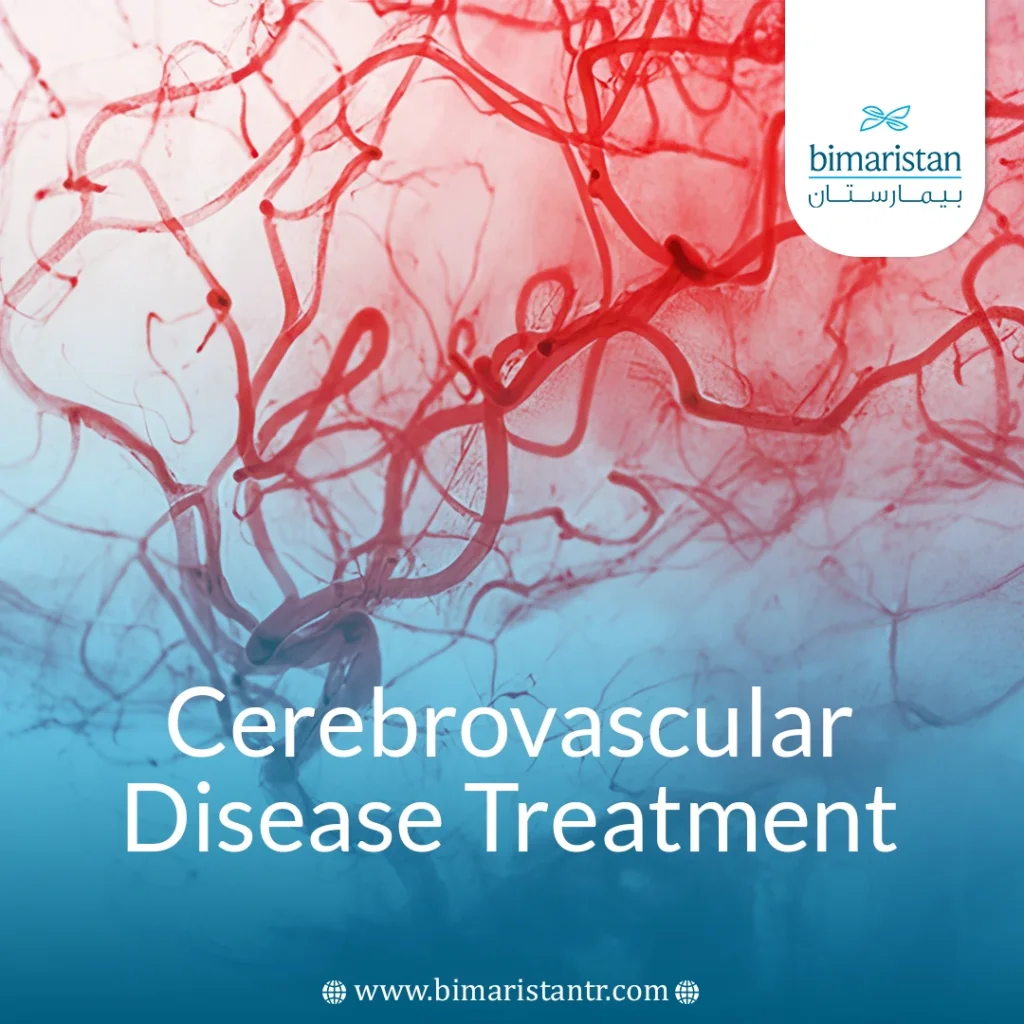Cerebrovascular diseases encompass a range of conditions that disrupt blood flow to the brain, including stroke, brain aneurysms, arterial stenosis, and intracranial bleeding. These illnesses can pose serious risks and demand urgent, specialized care. In this article, we highlight the most prominent cerebrovascular disease treatment approaches tailored to the specific condition and explore the latest medical and surgical options that enhance recovery prospects and support a better quality of life.
What are the most common cerebrovascular diseases that require urgent treatment?
Stroke
A stroke is a serious medical condition that occurs when brain cells do not receive adequate blood supply and oxygen, leading to the death of brain cells within minutes. It is caused by a blockage of a blood vessel in the brain by a thrombus.
Chronic cerebral ischemia
Chronic cerebral ischemia is a condition characterized by a continuous decrease in blood flow to the brain, due to narrowing of blood vessels or atherosclerosis, which leads to a gradual decrease in brain perfusion. The symptoms include memory impairment and difficulty concentrating. The incidence of chronic cerebral ischemia increases with age or the presence of diseases such as diabetes and hypertension.
Hemorrhagic Stroke
A brain hemorrhage is a potentially fatal medical emergency that occurs when a blood vessel in the brain bursts and causes bleeding, disrupting blood circulation and leading to damage to brain cells due to a lack of blood and oxygen.
Brain aneurysms
A bulge in a weak area of an artery inside the brain. The constant pressure pushes the weak part outward, forming a bubble-like bulge. When blood flows into this bulge, it expands further, much like a balloon that becomes thinner and more prone to bursting as it fills with air.
Carotid artery stenosis
Carotid artery stenosis is a condition that occurs when the carotid arteries, the large arteries located on both sides of the neck, become blocked. One or both arteries can be affected. This blockage is caused by the buildup of atheromatous plaque (fatty and cholesterol deposits). When this plaque obstructs normal blood flow through the carotid artery, it increases the risk of stroke.

Acute stroke treatment
Use of clot-dissolving stimulants (tPA)
An emergency intravenous medication that is able to dissolve the clot within 4 hours of the onset of symptoms. The sooner the medication is administered, the better the results, as early treatment increases the chances of survival and may minimize complications.
Stroke catheterization for clot retrieval
A surgical procedure used to remove a blood clot from a blood vessel. The surgeon accesses the blood vessel above or below the site of the clot (often in the leg or arm), inserts wires and catheters through a small puncture into the blood vessel. Using real-time radiographic imaging, the tools are carefully navigated through the vascular system to the location of the clot, where it is then removed to restore normal blood flow.
The difference in treatment between ischemic and hemorrhagic strokes
Ischemic and hemorrhagic strokes differ significantly in their causes, severity, and treatment methods, as shown in the following table:
| Comparison | Ischemic stroke | Hemorrhagic stroke |
| Reason | Blockage of a cerebral artery with a clot | Cerebral artery rupture and intracerebral hemorrhage |
| Essential medicines | Clot-dissolving stimulants (tPA) | Blood pressure-lowering medications and suspension of blood-thinning medication |
| Surgical intervention | Stroke catheterization for clot retrieval | Blood removal or repairing a ruptured vessel |
Impact of early intervention on cerebrovascular disease treatment outcomes
Cerebrovascular disease treatment is most effective when initiated promptly, as early intervention significantly improves the chances of survival and recovery without disabilities. Optimal outcomes are often achieved when clot-dissolving drugs are administered within the first 4 hours, while catheter intervention is most effective within 6–24 hours, depending on the condition. In cases of hemorrhagic clots, rapid treatment helps reduce brain pressure and prevent severe complications.
Cerebral hemorrhage treatment
Controlling high blood pressure
Controlling blood pressure is the most crucial aspect of cerebrovascular disease treatment, as it helps prevent further bleeding and lowers intracranial pressure, thereby minimizing brain tissue damage. In contrast, high blood pressure increases blood flow to the bleeding site.
Emergency surgery for major bleeding
Cerebrovascular disease treatment may involve urgent intervention when a hemorrhagic stroke leads to blood pooling, which raises pressure on surrounding brain tissue. In such cases, emergency surgery might be recommended if intracranial pressure becomes dangerously high, allowing the surgeon to evacuate the excess blood and alleviate the buildup compressing the brain.
Minimally Invasive Surgery
Cerebrovascular disease treatment may involve minimally invasive techniques that use precision instruments inserted through small skull openings to evacuate excess blood without damaging brain tissue. This is achieved using a catheter-guided tube to reach the bleeding site and either withdraw the blood or dissolve it with targeted medications, or by employing a surgical scope that gives the surgeon a direct view for accurate removal. These advanced methods reduce complications and promote faster recovery compared to conventional surgical approaches.
Survival and recovery rates according to bleeding site
Survival and recovery rates vary depending on the location of the hemorrhage, with intracerebral hemorrhages having a 60% survival rate, while brain stem hemorrhages only have a 30% survival rate.
Cerebral Aneurysm Treatment
Several surgical approaches are used to treat brain aneurysms, including traditional clipping, endovascular coiling, and stent-assisted coiling techniques.
| Comparison | Traditional surgery (Clipping) | Endovascular coiling | Stent-assisted coiling |
| Mechanism of action | Close the expansion with a metal clip from the outside | Filling the dilation with a metal coil to block blood flow via a catheter | Placing a stent inside the artery to guide the blood and prevent it from expanding |
| Type of intervention | Open surgery | Mild intervention (via catheter) | Mild intervention (via catheter) |
| Success rate | Very high (90-95%) | High (80-90) | High with recent improved results |
| Recovery time | Longest (days to weeks) | Shorter (one to several days) | Similar to endovascular coiling |
When should intervention occur before a blood vessel in the brain bursts?
Intervention before a rupture occurs if the dilation is significant, growing rapidly, causing severe symptoms, or if the patient is at high risk (high blood pressure, smoking, or family history).
Treatment of chronic cerebral ischemia
There are several treatments for chronic cerebral ischemia, including:
- Medications to widen arteries and improve perfusion
- Treating underlying causes, such as atherosclerosis or atrial fibrillation, with a defibrillator
- Actions to prevent recurrent strokes
- Physical therapy and rehabilitation to improve cognitive function
Latest Technologies in Cerebrovascular Disease Treatment
There are several modern techniques used in cerebrovascular disease treatment, including:
Micro-robotics Therapy
One of the most advanced technologies in cerebrovascular disease treatment is the use of tiny robots that assist surgeons in performing precise operations on cerebral blood vessels, thereby minimizing errors and enhancing accuracy and safety.
Interventional Cerebral Catheterization
Inserting thin catheters through blood vessels to access affected areas of the brain, treating bleeding or blocked vessels without requiring open surgery.
Gene and cell therapy in brain rehabilitation
A futuristic approach in cerebrovascular disease treatment involves injecting specialized genes or cells to stimulate the regeneration of damaged brain tissue and improve recovery after strokes or brain injuries.
Smart monitors to reduce the risk of recurrence
Devices that continuously monitor a patient’s health status and detect early signs of disease recurrence or complications, enabling quick and preventive intervention.
Rehabilitation after cerebrovascular disease treatment
Rehabilitation after cerebrovascular disease treatment is an essential part of the recovery journey, aiming to restore neurological functions and improve quality of life:
- Physical therapy programs to improve mobility and balance
- Speech therapy for post-stroke language disorders
- Psychological support and improved quality of life
Recovery time and your potential return to work or school
The duration of recovery after cerebrovascular disease treatment varies according to the severity of the case and the type of treatment. In mild cases, noticeable improvement may occur within weeks, whereas more serious conditions often demand extended rehabilitation over several months. The ability to return to work also varies by occupation—those in desk-based roles may resume duties within 1–3 months, while physically demanding jobs may require a recovery period of 6 months or longer.
Cerebrovascular disease treatment has advanced considerably, enabling favorable outcomes even in severe cases with prompt and proper intervention. It remains essential to consult specialists in neurosurgery or cerebrovascular care and commit to ongoing rehabilitation to minimize complications and support a stronger recovery.
Sources:
- Khaku, A. S., & Tadi, P. (2025). Cerebrovascular Disease. In StatPearls. StatPearls Publishing. Retrieved June 11, 2025
- NHS. (2024, September 12). Treatment for a stroke. NHS. Retrieved June 11, 2025

